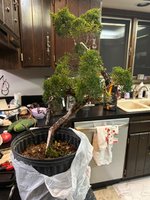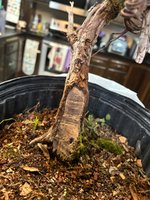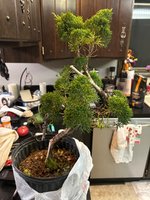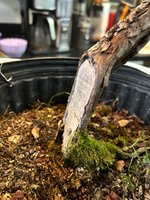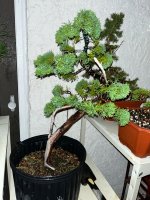You think I’m getting somewhere keeping these top branches in the mix?
I like it, and I think the top branches are creating a nice apex/“head” to the tree.
I also wonder what rotating the tree left or right would do in terms of orientation of the tree. Currently, the base of the trunk features an abrupt nearly straight up and down line (on the deadwood side) and then ascends and soon leads to a mirrored 45 degree angle up to the right then terminating at left, which looks 2-dimensional. Curious to know if rotating either a little left or right, making the trunk go away from the viewer then towards the viewer, would add depth, interest, and allow the tree to “bow towards the viewer” from the apex/head you are creating up top with the smaller branching.
It definitely is a beautiful tree (I really like it!) and am just posing the possibility of rotating to add some interest, more trunk movement, etc. Also wondering how the bent and jinned branch would appear upon rotating. Seems like a cool feature and still valuable upon rotating the tree (but it could be removed just as well to show off the slender trunk movement).
The issue with the trunk near the bottom (at left):
At the base of the trunk (at the current left side) where the deadwood and live vein interact, the deadwood part thins drastically almost disappearing before taking a right hand turn down toward the soil surface. It all almost creates the illusion of (or enhances) inverse taper.
The feature circled in the attached pic is where the eye is held captive upon first glance at the tree, and the viewer has to figure out what has happened at that portion of the trunk before viewing the rest of the tree.


